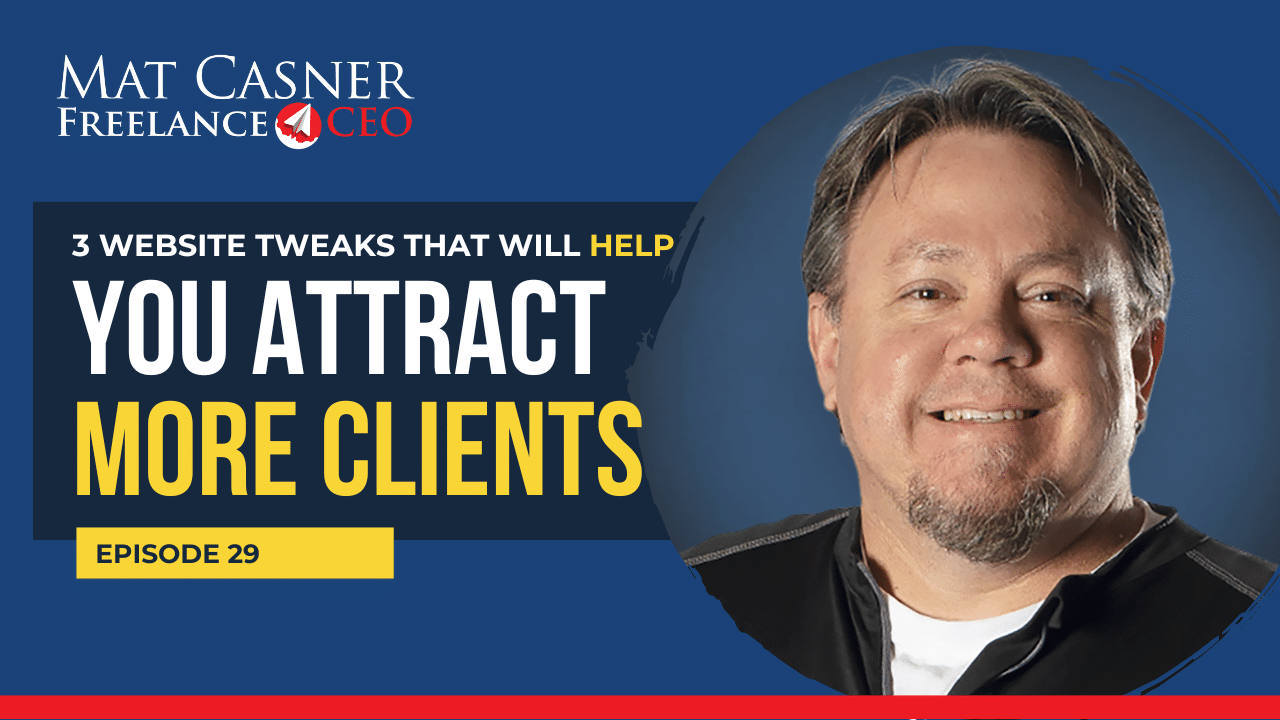
I want to talk about three things that you can do to make your website more attractive to your customer.
I’m gonna back up and I’m gonna kinda give you a little bit of the backstory in this conversation that I had with a friend. And we were talking and I was asking them, “Hey, how are things going with, you know, your business?” And we were chatting about different things that he was doing, and then I asked him, “So how’s your website responding?” And his answer was pretty typical. He’s like, “I have a website, but I really don’t know who’s going to it.” And so I said, “Okay, I get that. I mean, having a website is something that you can’t really keep eyes on 24 7.”
It’s always there. But how do you know it’s being effective? Well, I mean, there are some things you can do if you’re using, you know, some analytical tools to help analyze your website traffic. That’s very important. But I said, let me just take a look at your website and I’ll just make some observations. So I pulled his website up on my browser and it was a great looking website.
And so that’s, that’s one of the things that I kind of want to, you know, illustrate as we get started here. Your website’s, whether it is beautiful or rather ordinary in terms of effectiveness, isn’t necessarily the biggest game changer. I’m not saying not to have an aesthetically pleasing website. I think that kind of goes without saying, especially us as designers, we want things to look good. However, I think when it comes to a customer’s perspective, I think there are some things that we really need to be thinking about and doing some things that will really make our website more fine tuned to the people that are coming and visiting. So, one of the things that I noticed right away, and I’ve seen this on a lot of freelancer websites, is they will, you know, oftentimes they’ll put a picture of themselves, which I think is great, and then basically kind of a, a welcome message, which really, there’s nothing wrong with that either. And then directly below that kind of the welcome message, they had a few portfolio links that were there that the visitor could get to pretty easily.
So I’m looking at this friend’s website, and there were three things that I said, listen, if you could make a few little tweaks to your website, I know that you would have a much better response in terms of people that are coming to your website now, getting traffic to your website’s, a whole other topic, and I’m happy to talk about that later.
But the people that are coming, you want to be ready for them. So what I’m gonna do is I’m gonna share with you the three things that I recommended to my friend. And here’s the first thing. The first thing that I said is, I get it that you’re a graphic designer, but what are you really selling? I think this is something that a lot of graphic designers stumble on because they identify themselves as creatives.
I’m a creative, I’ve been a creative for a long, long time, and for a long, long time, the way I presented myself is I’m a creative guy. I’m a graphic designer. I do designs for print and for web. Okay? I build websites. You know what, what, whatever that, you know, whatever that sounds like, that’s very common in the industry. You will see a lot of people who pitch themselves as being the person who does designs. And again, there’s nothing wrong with that, but I think the place where we’re missing is the, the website that the graphic designer had, had a picture of them, but wasn’t clear on what they were really selling. And so that is my first little tip.
Make sure that the message that’s on your website is very clear with what you do. So make sure that it’s spelled out, and I say this because you and I are very, very familiar with websites, but I can tell you that probably 75% of my new customers, not my existing customers or re recurring clients, but probably 60 to 70% of my new customers have never really shopped for creative before.
They’ve never really had a website bid before, which is amazing. And there are people that are still out there trying to figure out, you know, how to get a website built. But it’s not like going out and buying a car where that’s, buying experience is somewhat familiar to people. When people buy creative, they are in uncharted water. So one of the things that we need to remember as business owners is that we need to reach out past halfway as we’re talking to our clients and explain to them in very explicit language what it is we do and how we help them.
So number one, what is your unique selling proposition? Is what I’d normally call that. Okay? So item number two is related to that, what goes right along with your unique selling proposition? In other words, what goes right along with telling somebody what you is following up that with what problems that you can solve for your clients. Bear in mind when I go to a car lot,
I’m usually going because I’m interested, okay? At some level, I’m interested. Either I really need a new car right now, or maybe I’m just shopping. Okay? Once I get to the car lot, if I find something there that really appeals to me, I may talk to a sales guy, maybe, maybe not, but if nothing is attractive there to me, nothing that I like, nothing that I need, I’m likely just gonna drive off the lot. In the web world, we call that a bounce. When someone visits your website and they immediately, you know, redirect, they hit the back button or they, they go to another address that’s called bouncing. And bouncing is not good, because what balancing means is there was a connection that failed,
We failed to connect with them as a business to a customer. Now, again, back up and ask yourself this question, why do people need us as graphic designers? Why, why do people need us? And I, I think a lot of people would come shopping for a graphic designer, number one, because maybe they need a new logo.
Maybe they need something designed for their business, a a piece of marketing or a piece of advertising. Maybe it’s a sign, maybe it’s a poster, maybe it’s a website, maybe it’s an email campaign, whatever it is. Usually people are gonna talk to us because they have a need motivated by their business. So that is a pain point for them.
They’re struggling right now. They don’t know who to call, they don’t know who to talk to, and they know they have this need, but they don’t know who to trust yet, who to spend their money with yet. And that underlying question, what pain points or what trouble or what problems do you solve goes right to the level of trust. The more that we can convince our audience that we have a product that either answers their questions, solves their problem, or relieves a pain point, then they will start to, the risk level starts to come down because they’re looking for a solution. They’re looking for a partner. Are you the right partner for them? That’s what they’re trying to determine. So with our messaging on our website, we have this opportunity to disarm. We have this opportunity to create trust, and the more that we can talk to them about the specific problems that they have, and show them that we have the answer, that’s going to help us in the sales cycle. Now, I’m gonna divert here just a little bit because I’ve talked about the messaging, your value proposition being very important. I’ve talked about the messaging of the problems that you solve being very important.
Let me just say this, this is a fact. So have shown that the average time that someone spends on a website for the first time is four seconds. 1000, two, 1000, three 1000, four 1000. Bounce. That’s not very long that they say that a goldfish has an attention span of seven seconds. So that’s almost double what a normal person would spend on a website.
Well, guys, four seconds is not long at all, okay? It goes by in a flash. So one of the things I want you to remember is that the part of your website that loads first at the top of the screen above the fold, is the most precious and valuable real estate that you own. As a business owner, you may have a beautiful portfolio, you may have a ton of content and blogs on your website, but believe me, they will never see it if you do not capture their attention in the first four seconds. So again, that’s why I put such high emphasis on the part of your website that people see at the very top. You can essentially let the rest of it go until you have that nailed down.
So with that being said, this is where the third and final point that I wanted to share this tip that I gave to my friend, I’m like, I’m looking at your website and someone comes here. You are, you’re doing nothing to start a conversation. People come to your website, they are interested in you. They were interested enough to click on a link and visit your website. That at least shows some initiative. Now, maybe they’re just kicking a tire, they just wanna see what your site looks like. I, I don’t know. I, I, I can’t tell you why other than they were motivated. The least we can do, and what we should do is within that four second window that we have them on our webpage.
We need to talk to them, and we need to start a conversation. So a conversation can look like a lot of different things. It’s generally not gonna be just, hi, my name is Matt and I’m a graphic designer. That’s not starting a conversation that’s stating the obvious. Once I have communicated my value proposition, once I have demonstrated what problems I can solve, then the third and logical step is to invite that person to talk to you. Now, that can be a lot of different things. It can be pick up a phone and give me a call. It can be click on a link for more information on what services I have that would be appealing to you. It would maybe be, offer them a free resource that would be specifically related to whatever pain point they have, whatever problem they’re trying to solve. If you have a guide that you can, you can give to them, that would be helpful. Make that available to them. Give them something. Maybe you just want a link to a contact page, or maybe you want to, you know, invite someone to schedule a, an appointment, a free consultation, a free session, whatever it is, make sure that you know the top part of your website above the fold, that there is a conversation starter. Okay? Make sure that people see it. Make sure that people have to walk away from it. If you say something like, I’m ready to help you and contact me now, or call me.
That’s basically offering them a hand—that’s starting a conversation.
Now, people can choose whether or not they want to respond to that or not, but here’s the trick. They are responding When you have no ask, when you have no conversation started on your website, there’s nothing for them to say no to. They can just bounce and go right away. But if you offer a conversation,
if you start a conversation while they’re there on your website, they have to make a conscious decision once they, once they’ve read it, whether to engage with you or not. It makes a difference. It’s like, we’ll miss a hundred percent of the shots that we don’t take. But I guarantee you that a percentage of the people that come to your website that see what your value proposition is, they see what problems you can solve. And if they can relate to those two things and see that you’re reaching out and asking to help them, there’s gonna be a certain percentage of people that says, yep, this is my person. I want to talk more. Okay? So you start that conversation. I’m not saying you’ve got ’em as a client yet, but you started the conversation and that to me, guys, is one of the hardest things to do. It’s to get that initial conversation started. Once you get that person and you get a chance to meet them, then it’s about building trust. It’s about getting that person to understand that you’re on their team and that you have what they need to help solve their problem, heal their pain, whatever it is. Awesome. So I’m just gonna recap here. The three things that I’ve, I’ve said, this is things that anybody can fix on their website. All you have to do is spend a little bit of time, think about your client, think about what you do, think about what pain points you solve, and then find a way to start a conversation, engage that visitor and get them to have some sort of a dialogue. Start that dialogue.


